What is Gyga file
The .[gygabot@cock.li].gyga extension is a file extension that is used by the latest variant of the Crysis/Dharma ransomware to mark files that have been encrypted. Gyga ransomware is a malicious program that encrypts user files and demands a ransom for a key-decryptor pair that is necessary to decrypt the affected files. It uses a strong encryption system and a long key, which virtually eliminates the possibility of decrypting files without a key. Files encrypted with .[gygabot@cock.li].gyga extension become useless, their contents cannot be read without the key that the criminals have.
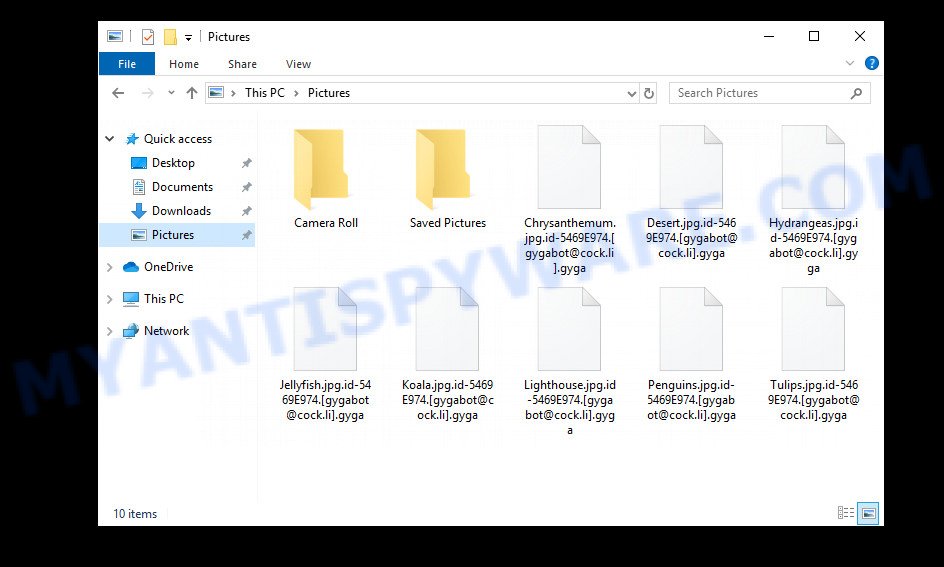
Files encrypted with .[gygabot@cock.li].gyga extension
What is Gyga ransomware virus
Gyga ransomware is one of the variants of Dharma/Crysis ransomware. The most common source of infection are torrents files, freeware, cracked apps and games, Windows and Microsoft Office activators, and other similar software. Upon execution, it encrypts files using a key that is individual for each computer. Gyga ransomware uses a very strong encryption system, which eliminates the possibility of determining the key, even using a super computer. The encryption process is very fast, regardless of what is in the file, the virus can easily encrypt it. Gyga can encrypt almost all files that are on the computer, including those located on network drives. The only thing that the virus does not encrypt is the files that are necessary for the Windows OS to function normally. Below we list some types of files that can be encrypted by the ransomware:
.sum, .avi, .wp7, .wsh, .wma, .rgss3a, .eps, .mpqge, .docx, .xls, .mrwref, .pak, .srw, .pef, .qic, .wp, .zip, .xlsx, .wmv, .2bp, .wpt, .pkpass, .p7c, .wpd, .xyw, .cer, .vdf, .das, .wpd, .crt, .psd, .lrf, .mlx, .qdf, .xy3, .syncdb, .wpa, .wgz, .y, .indd, .upk, .big, .dmp, .rofl, .xyp, .srf, .odt, .ppt, .wbc, .vpk, .fpk, .cfr, .mov, .ltx, .m2, .pst, .z, .jpe, .odm, .menu, .wpb, .xwp, .bay, .ws, .wbd, .litemod, .wbz, .ybk, .zw, .xpm, .hkdb, .fsh, .hplg, .bkp, .xar, .crw, .w3x, .pdd, .ncf, .xdl, .xlsm, .bc6, .wps, .flv, .kdc, .erf, .m3u, .jpeg, .xll, .pdf, .accdb, .wps, .yal, .map, .doc, .wma, .epk, .re4, .ntl, .sql, .yml, .css, .hvpl, .dazip, .xx, .snx, .asset, .xdb, .wcf, .p7b, .pptm, .der, .xls, .txt, .webdoc, .rwl, .bkf, .gdb, .hkx, .cdr, .cr2, .wbmp, .arch00, .xmmap, .rar, .tax, .sidn, .wri, .mdb, .mp4, .kdb, .x, .mdf, .tor, .wpg, .desc, .pptx, .bik, .iwd, .wav, .wot, .nrw, .odp, .vtf, .odc, .py, .r3d, .vcf, .wsd, .gho, .fos, .ods, .apk, .png, .bsa, .icxs, .mef, .t12, .d3dbsp, .wp6, .iwi, .x3f, .wmf, .bar, .zabw, .vpp_pc, .arw, .dba, .ysp, .xbplate, .rw2, .7z, .xf, .zdc, .dng, .wdp, .3dm, .jpg, .cas, .0, .slm, .rb, .orf, .blob, .wpw, .raw, .sidd, .m4a, .xmind, .mddata, wallet, .csv, .wpe, .dcr, .itl, .mcmeta, .wp4, .wb2, .pfx, .wn, .itm, .wpl, .ptx, .xxx, .dbf, .xbdoc, .wp5, .wm, .sav, .xlsm, .esm, .docm, .xlsx, .rim, .ff, .t13, .svg, .rtf, .wbm, .xml, .3ds, .ibank, .lbf, .sie, .x3f, .sr2, .xlk, .p12, .x3d, .zif, .raf, .wotreplay, .xld, .ztmp, .wmv, .sis, .zip, .xlgc, .wsc, .layout, .wmo, .lvl, .1, .vfs0, .zdb, .z3d, .wdb, .webp, .kf, .itdb, .odb, .wire, .forge, .psk
When a file is encrypted, ‘.id-USERID.[EMAIL-ADDRESS].gyga’ is added at the end of its name, that is, if you had a file of ‘document.docx’, then a file with the name ‘document.docx.id-USERID.[EMAIL-ADDRESS].gyga’ will appear in its place. If you change the file name, just delete the added extension, then nothing will change. The file will remain encrypted, and as before, this file will not be possible to open in the program with which it is associated.
Perhaps you found on your computer or its desktop a new file called ‘FILES ENCRYPTED.txt’, which for some reason is not encrypted. An example of such a file is given below.
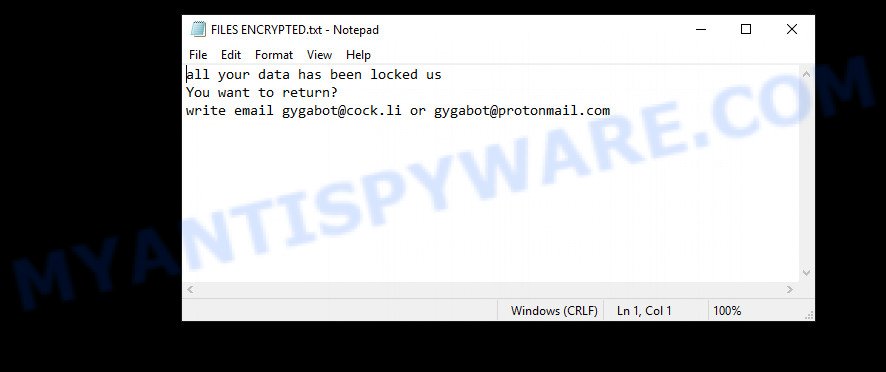
Gyga ransomwnote
This file is very important, in addition to containing a ransom demand, it also contains information that allows you to contact intruders. According to the message, the victim is invited to contact the attackers using the given email address. In response, the authors of the virus will give a Bitcoin address to which the ransom must be transferred. Of course, you should understand that there is no guarantee that the attackers, after receiving the ransom, will provide you with the key necessary to decrypt your files. In addition, by paying the ransom, you will push attackers to create a new ransomware.
The contents of the FILES ENCRYPTED.txt file:
all your data has been locked us
You want to return?
write email gygabot@cock.li or gygabot@protonmail.com
Threat Summary
| Name | Gyga ransomware, Gyga file virus |
| Type | File locker, Crypto malware, Crypto virus, Filecoder, Ransomware |
| Encrypted files extension | .gyga |
| Ransom note | FILES ENCRYPTED.txt |
| Contact | gygabot@cock.li, gygabot@protonmail.com |
| Ransom amount | $500-$1500 in Bitcoins |
| Detection Names | Trojan/Win32.Crysis.R213980, Trojan.Ransom.Crysis.E, Win32:RansomX-gen [Ransom], AI:Packer.D3B9457E1E, Ransom.Crysis.A3, Trojan.Encoder.3953, W32/Wadhrama.B, Win32.Trojan-Ransom.VirusEncoder.A, Trojan-Ransom.Win32.Crusis.to |
| Symptoms | Unable to open files. Your files have a wrong name, suffix or extension, or don’t look right when you open them. Files named like ‘FILES ENCRYPTED.txt’, ‘#_README_#’, ‘_DECRYPT_’ or ‘recover’ in each folder with at least one encrypted file.. New files on your desktop, with name variants of: ‘HOW_TO_DECRYPT.txt’, ‘DECRYPT.txt’ or ‘README.txt’. |
| Distribution methods | Malicious e-mail spam. Drive-by downloading (when a user unknowingly visits an infected website and then malware is installed without the user’s knowledge). Social media posts (they can be used to force users to download malware with a built-in ransomware downloader or click a malicious link). Remote desktop protocol (RDP) hacking. |
| Removal | Gyga ransomware removal guide |
| Recovery | Gyga File Recovery Guide |
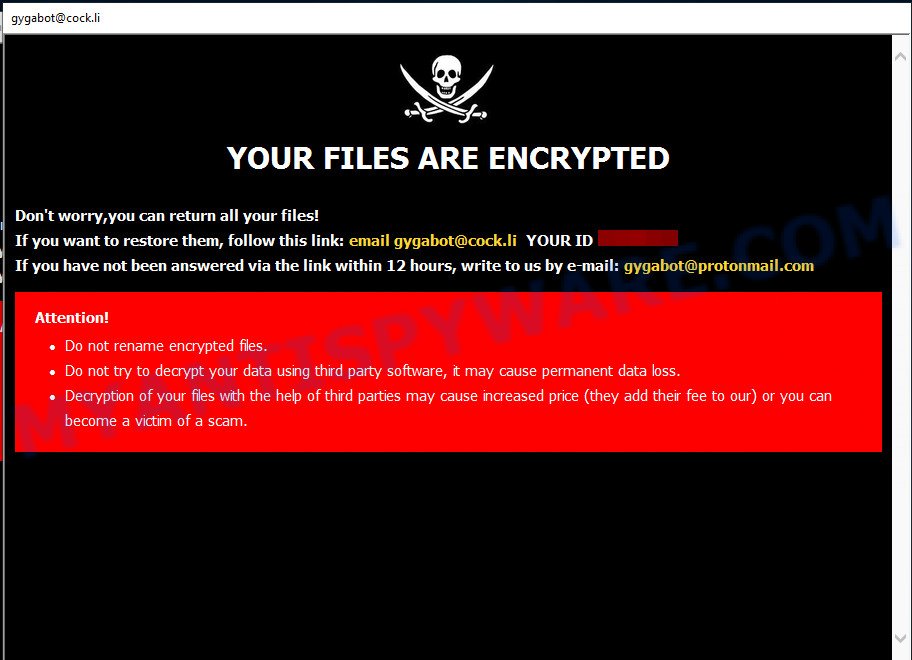
Gyga ransomware popup window
The full text of the message that appears in the Gyga popup window:
YOUR FILES ARE ENCRYPTED
Don’t worry,you can return all your files!
If you want to restore them, follow this link:email gygabot@cock.li YOUR ID XXXXXXX
If you have not been answered via the link within 12 hours, write to us by e-mail:gygabot@protonmail.com
Attention!
Do not rename encrypted files.
Do not try to decrypt your data using third party software, it may cause permanent data loss.
Decryption of your files with the help of third parties may cause increased price (they add their fee to our) or you can become a victim of a scam.
As we have already said, Gyga is not the first ransomware from the Crysis/Dharma family. The fact that to date, antivirus companies have not created a way to decrypt files, and just have not found a 100% way to protect the user’s computers, indicates the complexity of the ransomware and the method that it uses to encrypt files. Nevertheless, you do not need to despair. There are several ways to find and remove Gyga ransomware, and there is also a chance to restore part or even all encrypted files to their original state. Below we will describe in detail how to do this.
How to remove Gyga ransomware, Restore .[gygabot@cock.li].gyga files
If your files have been encrypted with ‘.[gygabot@cock.li].gyga’ extension, then first of all you need to remove Gyga ransomware and be 100% sure that there is no active ransomware on your computer, and then proceed to restore the files. Both the ransomware removal process and the file recovery process will take a lot of time, so do not believe the magical instructions that say that this can be done very quickly. We definitely recommend, even if for some reason one of the methods proposed below did not suit you, try another one and try all of them. Perhaps one of them will help you. Feel free to ask questions in the special section on our website or in the comments below. And the last, before proceeding with the instructions, we advise you to read it thoroughly carefully, and then print or open it on a tablet or smartphone to have it always at hand.
- How to remove Gyga ransomware
- How to decrypt .gyga files
- How to restore .gyga files
- How to protect your personal computer from Gyga ransomware
How to remove Gyga ransomware
First you need to remove Gyga ransomware autostart entries before decrypting and recovering encrypted files. Another option is to perform a full scan of the computer using antivirus software capable of detecting and removing ransomware infection.
It is very important to scan the computer for malware, as security researchers found that spyware could be installed on the infected computer along with the Gyga ransomware. Spyware is a very dangerous security threat as it is designed to steal the user’s personal information such as passwords, logins, contact details, etc. If you have any difficulty removing Gyga ransomware, then let us know in the comments, we will try to help you.
To remove Gyga ransomware, use the steps listed below:
Kill Gyga ransomware
Press CTRL, ALT, DEL keys together.

Click Task Manager. Select the “Processes” tab, look for something suspicious that is the Gyga ransomware then right-click it and select “End Task” or “End Process” option.
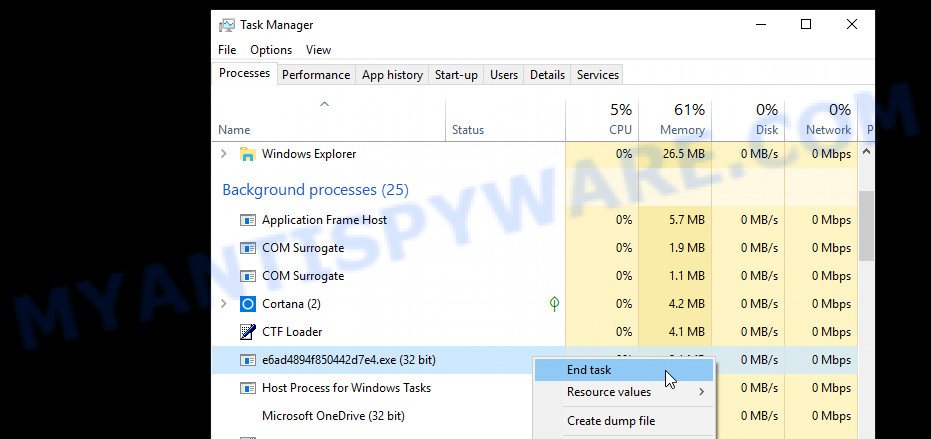
A process is particularly suspicious: it is taking up a lot of memory (despite the fact that you closed all of your programs, its name is not familiar to you (if you are in doubt, you can always check the program by doing a search for its name in Google, Yahoo or Bing).
Disable Gyga ransomware Start-Up
Select the “Start-Up” tab, look for something similar to the one shown in the example below, right click to it and select Disable.
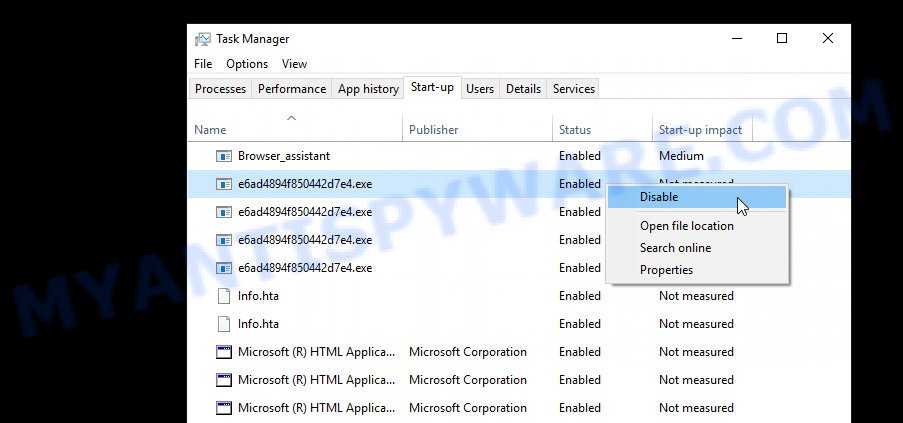
Close Task Manager.
Scan computer for malware
Zemana Anti-Malware can detect all kinds of ransomware, as well as a variety of Trojans, viruses and rootkits. After the detection of the Gyga crypto malware, you can easily and quickly uninstall it.
Visit the page linked below to download the latest version of Zemana for MS Windows. Save it on your Desktop.
164813 downloads
Author: Zemana Ltd
Category: Security tools
Update: July 16, 2019
When the download is complete, close all applications and windows on your PC system. Double-click the install file called Zemana.AntiMalware.Setup. If the “User Account Control” dialog box pops up as shown on the screen below, click the “Yes” button.

It will open the “Setup wizard” which will help you install Zemana Anti-Malware (ZAM) on your computer. Follow the prompts and don’t make any changes to default settings.

Once installation is complete successfully, Zemana Free will automatically start and you can see its main screen as displayed on the image below.

Now click the “Scan” button to perform a system scan for the Gyga ransomware virus and other security threats.

When the scan is finished, you may check all items detected on your computer. Next, you need to press “Next” button. The Zemana will begin to delete Gyga ransomware, other malicious software, worms and trojans. When the task is finished, you may be prompted to restart the machine.
If you have already used some malware removal tools, they found and removed malware, then in order to be 100% sure that the computer no longer has the Gyga ransomware, we recommend using the Kaspersky virus removal tool (KVRT). It is free and easy to use. KVRT can scan and delete ransomware, spyware, PUPs, worms, trojans, adware and other malware. It is powerful enough to find and delete malicious registry entries and files that are hidden on the personal computer.
Download Kaspersky virus removal tool (KVRT) by clicking on the link below.
129233 downloads
Author: Kaspersky® lab
Category: Security tools
Update: March 5, 2018
When the downloading process is complete, double-click on the Kaspersky virus removal tool icon. Once initialization procedure is finished, you will see the Kaspersky virus removal tool screen as shown on the screen below.

Click Change Parameters and set a check near all your drives. Click OK to close the Parameters window. Next click Start scan button . KVRT program will scan through the whole machine for the Gyga ransomware and other malicious software. This task can take quite a while, so please be patient. While the KVRT application is checking, you can see how many objects it has identified as threat.

After the scan get completed, KVRT will display a list of all threats detected by the scan as displayed on the image below.

Next, you need to click on Continue to begin a cleaning procedure.
How to decrypt .gyga files
All files with the ‘.[gygabot@cock.li].gyga’ extension are encrypted. Their contents cannot be unlocked simply by removing this extension or completely changing the filename. Unfortunately, as we already reported in this article, there is currently no way to decrypt files. The reason for this is the complexity of the encryption algorithm that the authors of Gyga virus use. In principle, this is what the attackers sought. But this does not mean that you have no choice and you need to pay a ransom for your files.

Never pay the ransom! Any security expert will tell you this. Of course, there is a chance that by paying a ransom, Gyga virus authors will allow you to unlock your files, but there is no guarantee. Moreover, you should understand that when you pay a ransom, you unknowingly push the attackers to create new, even more destructive viruses.
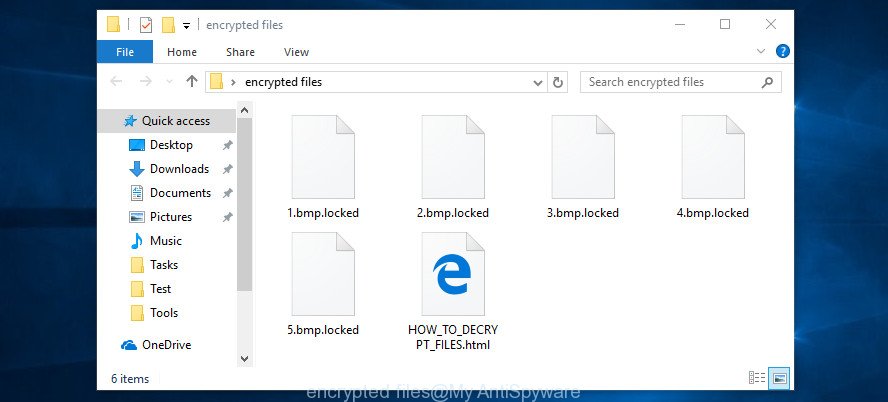
Do not forget that besides you, thousands more people around the world have lost their files, that is, you are not alone. Antivirus companies, security experts are working on something that will allow you to decrypt .[gygabot@cock.li].gyga files. Perhaps in the future an universal method will be developed that will allow all victims to unlock all their data.
Of course, as soon as a way to decrypt the files appears, we will post a message about this to this article or to our facebook account. Therefore, we recommend that you follow the updates.
How to restore .gyga files
As we wrote above, you cannot decrypt files encrypted with Gyga ransomware. But you can use a different way, there is a small chance to restore .[gygabot@cock.li].gyga files without decrypting them. Programs created for searching and recovering lost and deleted data can help you with this. We recommend you to use the following free programs: PhotoRec and ShadowExplorer. Two more things we want to say about. First, before restoring files, you must be 100% sure that there is no ransomware on the computer. We recommend using free malware removal tools that we examined in this article. Second, and what is very important! The less you use your computer after ransomware infection, the higher the chance that you will be able to recover encrypted files.
Restore .gyga files with ShadowExplorer
First of all, try to recover your files using a free tool called ShadowExplorer. This program will allow you to recover your files from Shadow Volume Copies. These copies are created automatically by the OS when you work with your files. Unfortunately, very often, the virus automatically deletes all these copies and thus prevents the user from recovering encrypted files. Nevertheless, in some cases, the ransomware cannot delete all copies, and the user gets the opportunity to quickly restore all files. Therefore, our opinion, you should definitely try this method!
Visit the page linked below to download the latest version of ShadowExplorer for Windows. Save it on your Desktop.
439456 downloads
Author: ShadowExplorer.com
Category: Security tools
Update: September 15, 2019
After the downloading process is done, extract the downloaded file to a directory on your PC system. This will create the necessary files as on the image below.

Launch the ShadowExplorerPortable program. Now choose the date (2) that you wish to recover from and the drive (1) you wish to restore files (folders) from such as the one below.

On right panel navigate to the file (folder) you wish to restore. Right-click to the file or folder and press the Export button as displayed below.

And finally, specify a folder (your Desktop) to save the shadow copy of encrypted file and click ‘OK’ button.
This video step-by-step guide will demonstrate How to recover encrypted files using Shadow Explorer.
Use PhotoRec to recover .gyga files
Another really working way to recover your encrypted files is to use a program named PhotoRec. It is created to recover deleted or lost files. Does the Gyga ransomware block this method? Fortunately, the ransomware cannot block this method of recovering the contents of encrypted files. The more you used (moved, deleted, modified) files before infection, the greater the chance that you will be able to recover them.
Download PhotoRec on your computer from the following link.
When the downloading process is complete, open a directory in which you saved it. Right click to testdisk-7.0.win and choose Extract all. Follow the prompts. Next please open the testdisk-7.0 folder as shown on the image below.

Double click on qphotorec_win to run PhotoRec for Microsoft Windows. It’ll display a screen like below.

Select a drive to recover as shown below.

You will see a list of available partitions. Choose a partition that holds encrypted photos, documents and music as displayed below.

Press File Formats button and choose file types to restore. You can to enable or disable the restore of certain file types. When this is done, click OK button.

Next, click Browse button to select where restored documents, photos and music should be written, then click Search. We strongly recommend that you save the recovered files to an external drive.

Count of restored files is updated in real time. All recovered documents, photos and music are written in a folder that you have chosen on the previous step. You can to access the files even if the recovery process is not finished.
When the restore is done, click on Quit button. Next, open the directory where recovered files are stored. You will see a contents as displayed in the figure below.

All restored photos, documents and music are written in recup_dir.1, recup_dir.2 … sub-directories. If you’re searching for a specific file, then you can to sort your recovered files by extension and/or date/time.
This video step-by-step guide will demonstrate How to recover encrypted files using PhotoRec.
How to protect your personal computer from Gyga ransomware
Most antivirus software already have built-in protection system against the crypto virus. Therefore, if your personal computer does not have an antivirus application, make sure you install it. As an extra protection, use the HitmanPro.Alert. HitmanPro.Alert is a small security tool. It can check the system integrity and alerts you when critical system functions are affected by malware. HitmanPro.Alert can detect, remove, and reverse ransomware effects.
First, visit the page linked below, then press the ‘Download’ button in order to download the latest version of HitmanPro Alert.
Once downloading is done, open the folder in which you saved it. You will see an icon like below.

Double click the HitmanPro Alert desktop icon. When the utility is opened, you’ll be displayed a window where you can select a level of protection, as displayed on the screen below.

Now click the Install button to activate the protection.
To sum up
This guide was created to help all victims of the Gyga ransomware virus. We tried to give answers to the following questions: how to remove ransomware; how to recover .[gygabot@cock.li].gyga files. We hope that the information presented in this manual has helped you.
If you have questions, then write to us, leaving a comment below. If you need more help with Gyga related issues, go to here.




















